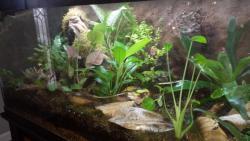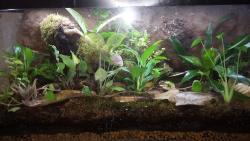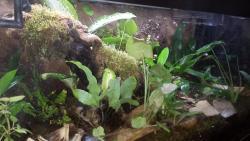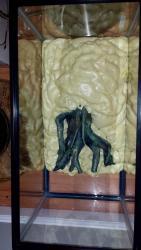My husband and I received an old 35-gallon aquarium that used to hold reptiles. We were told that it would not hold much water, so it could not be used as a aquarium to hold many fish. We decided to make a terrarium.



The first thing you need to do is to clean it very well. We used a bleach-water solution and razor blades. Just make sure not to scratch the glass. Then rinse the terrarium thoroughly.
The next step is to add a background. Your background actually will eventually look like a fake wall or backdrop. You'll need to use Great Stuff™. It's used in some insulation, and you probably want to make sure to get the white color. If you are going to use any sticks, rocks, or roots in your backdrop, then you'll need to make sure to put them in place before applying the Great Stuff™. If you want a waterfall feature, then you'll need to use Great Stuff™ around your cord for the waterfall and pump at the bottom and around the rocks you are using for the water to trickle down. Leave a space of about 2 or 3 inches from the bottom of the terrarium and start "Great Stuffing" the wall in odd random shapes. You should also make some thick spots so you can cut in to add pots later for wall-spreading plants. Once you get your Great Stuff™ fully on the wall and as thick as you want it (it does expand!), then you need to let it dry for a few days.

Once it is dry, take a knife you don't mind completely ruining and make your holes for your pots. Clean up that area at the bottom so it is a smooth 2 to 3 inches of clean space, and also do this at the top. Then get some aquarium silicone in brown and some gloves. It's better to go overboard with this process than under, because this keeps water from getting into your Great Stuff™. Completely cover the Great Stuff™. Get into all of the nooks and crannies. It doesn't matter if you get it on the aquarium itself because it can be removed easily with a razor blade. I think we used about 4 cans of silicone for our 35-gallon aquarium, so this can give you an idea of how densely covered everything needs to be.
While the silicone is still wet, take a lot of dried coco fiber and pack it onto the silicone to give it a "dirt look."
Let your terrarium set for a few more days with the coco fiber packed on there. Then remove the coco fiber and see whether you missed any spots. If you did, you can apply more silicone and coco fiber to those spots.
After this, take some more silicone and glue in your pots. Make sure that the hole you dug is longer than the pot so it can have some drainage, but don't make the holes larger than the pots or you'll need to apply more Great Stuff™, silicone, and coco fiber.
Then get some HydroBalls™. You usually can order them from any pet store Make sure to spread a full layer on the bottom of the terrarium. If you want to add a "pond" at the bottom for fish or for the waterfall to land, apply silicone to the glass on the bottom of your pond. Make sure the pond is water tight so it won't leak into the dirt or HydroBalls™.
Next, you need some separator material. We actually used the mesh you get for windows when you want to open them, and we doubled it up. We put that on the bottom of just the HydroBalls™ and then filled the rest with dirt, a little bit past the Great Stuff™ wall. We used ABG Mix. It's what Atlanta Botanical Gardens uses for their terrariums. We also filled up our little pots with the same mix, and then came the fun part -- planting!
We ordered all of our plants and the planting mix from Josh's Frogs. When you choose the plants, you first will have to determine whether you will have animals in the terrarium. If you will, then you will need to make sure the plants you put in there won't poison the animals or get killed by the animals trampling them. You will also need to remember that your plants will grow bigger, so guard against overcrowding. Josh's Frogs actually has kits for terrariums of various sizes. What's great is that you can have orchids, bromeliads, ferns, vines,, etc. Make sure you get some vines and other plants that will fill out on your wall.
After this, you can simply add decorations. We added a lot of grape leaves, sphagnum moss, and live moss, along with colorful rocks and driftwood. Make sure you put a glass lid on the top so the humidity stays constant. Get a good terrarium light. Two other accessories you might want to purchase are a mister, so you won't have to worry about misting everything yourself, and a humidity/temperature gauge, especially if you're planning to have critters in there. You have just made a lovely centerpiece for your house!
| Thread Title | Last Reply | Replies |
|---|---|---|
| Great idea! by KyWoods | Oct 23, 2014 4:17 PM | 10 |